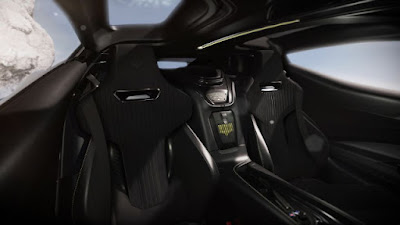Most UNIQUE Ones - In the realm of modern auto design, events like the Geneva Motor Show stand out as hubs of innovation and creativity. Over the years, these prestigious gatherings have seen the debut of numerous concept cars that push the boundaries of traditional design.
While many of these concepts showcase sleek lines and futuristic aesthetics, there are also those that defy convention with their unusual and sometimes downright weird designs as you can see on the the
Alfa Romeo Carabo.
Another notable example is the
1963 Chevrolet Corvair Testudo by Bertone. Created with the European market in mind, this concept car featured a design that was ahead of its time.
Nuccio Bertone himself drove the
Testudo to the
1963 Geneva Motor Show, showcasing its innovative approach to automotive styling.
 |
| 1963 Chevrolet Corvair Testudo by Bertone. (Picture from: ClassicDriver) |
Moving ahead to 1968, we encounter the Bertone Panther, a prototype developed for the World Sportscar Championship. What set the Panther apart was its distinctive spoiler, which could be adjusted hydraulically for optimal performance—a feature that was truly ahead of its time.
In 1970, BMW collaborated with Bertone to create the BMW 2200 ti Garmisch. Designed by Marcelo Gandini, this concept car left a lasting impact on BMW's design language, influencing future models like the E12 5 Series. Despite not carrying over all its design elements, the Garmisch remains a testament to Bertone's creative prowess.
Fast forward to
1981, and we encounter the
Wolfrace Sonic—a promotional vehicle that showcased
Wolfrace's innovative alloy wheels. With
its six wheels and twin Rover V8 engines, the
Sonic captured the imagination of enthusiasts, earning its place alongside iconic supercars of the era.
 |
| 1981 Wolfrace Sonic. (Picture from: ViaRetro) |
In 1987, Sbarro unveiled the Monster G—a truly bizarre concept car that combined elements from a Mercedes G-Wagon, a beach buggy, and even wheels from a Boeing 747. This eclectic blend of influences resulted in a vehicle that defied categorization, sparking curiosity and intrigue among automotive enthusiasts.
 |
| 1987 Sbarro Monster G. (Picture from: Sbarro) |
These concept cars, spanning from the 1960s to the 1980s, highlight the diverse landscape of automotive design. Each one represents a unique vision and a departure from the norm, contributing to the rich tapestry of automotive history.

As we delve into these unconventional designs, we encourage readers to share their thoughts and even recommend other quirky cars that merit recognition. The realm of concept cars is a canvas of boundless creativity, where imagination reigns supreme. This can also be observed in other unique examples, such as
Ferrari's seven odd cars.
*** [EKA [13042016] | FROM VARIOUS SOURCES | CLASSIC DRIVER | CARSTYLING.RU | OLDCARCONCEPTS | VIARETRO | SBARRO ]Note: This blog can be accessed via your smart phone.



 Boano's ascent to prominence was propelled by its groundbreaking work on the Alfa Romeo 6C 3000 CM (Competizione Maggiorata). Commissioned in 1954 for the President of Argentina, Juan Perón, this sleek masterpiece captivated the automotive world with its impressive speed and craftsmanship, firmly establishing Boano as a leading force in car design.
Boano's ascent to prominence was propelled by its groundbreaking work on the Alfa Romeo 6C 3000 CM (Competizione Maggiorata). Commissioned in 1954 for the President of Argentina, Juan Perón, this sleek masterpiece captivated the automotive world with its impressive speed and craftsmanship, firmly establishing Boano as a leading force in car design.





 Boano's commitment to excellence and innovation distinguishes it, leaving behind a legacy celebrated by enthusiasts and historians alike for its enduring impact on automotive history. As we reflect on Boano's journey, we are reminded of the timeless allure of its creations, standing as a testament to the artistry and craftsmanship of a bygone era. *** [EKA | FROM VARIOUS SOURCES | VIARETRO | VELOCETODAY | CARROZZIERI-ITALIANI | AUTO.CZ | RACINGSPORTSCARS | SUPERCARS.NET ]
Boano's commitment to excellence and innovation distinguishes it, leaving behind a legacy celebrated by enthusiasts and historians alike for its enduring impact on automotive history. As we reflect on Boano's journey, we are reminded of the timeless allure of its creations, standing as a testament to the artistry and craftsmanship of a bygone era. *** [EKA | FROM VARIOUS SOURCES | VIARETRO | VELOCETODAY | CARROZZIERI-ITALIANI | AUTO.CZ | RACINGSPORTSCARS | SUPERCARS.NET ]



































